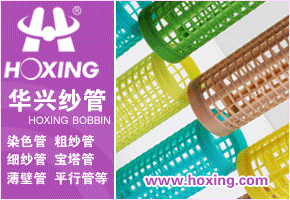China's Shaoxing to build global textile hub
China's textile hub, Shaoxing County in Zhejiang Province is planning to build an online sales platform to market the industry worldwide.
According to the Shaoxing Entry-Exit Inspection and Quarantine Bureau, China produces more than 70 percent of the world's clothes. About 60 percent of that production comes from Zhejiang and Jiangsu provinces.
Sun Chengrong, vice director at a Shaoxing textile industry group, said the area has established itself as a one-stop shop for the world's textile manufacturers and clothing designers.
"If you cannot buy a material for clothes here, you won't be able to find it anywhere else around the world," Sun said. Shaoxing County produced 16 billion meters of dyed fabric last year, 27.7 percent of the national total. According to a China Daily report, Shaoxing's textile industry accounted for more than 60 percent of the county's economic output, with exports of US$6 billion in 2009.


China's textile hub, Shaoxing County in Zhejiang Province produced 16 billion meters of dyed fabric last year, 27.7 percent of the national total.
Local government official Miao Shuixiang said the textile industry of Shaoxing is working towards creating an industrial sector that fosters "technology innovation, sustainable development and a reasonable and defined industry system."
"We try to promote companies that innovate in fabric weaving and dyeing," Miao said. "We aim to be authoritative at home and influential abroad."
Over the coming five years, the Shaoxing local government plans to invest more than 2 billion yuan to build "an online textile city"to promote its achievements worldwide.
Sun said the plan "will concentrate information on the textile industry, trade data and public services by integrating the value chain of information flow, capital flow, logistics and customer relations."
New challenges
In 2008, while much of the world was reeling in the depths of the financial crisis, China's textile industry started to accelerate as the U.S. dollar against the yuan. "In fact, it was a bull market for China's textile industry in 2009 and 2010,"Sun said.
The industry's focus on China's domestic market, which accounts for two-thirds of total sales, helped shield it from the global slowdown, Sun said. "Many local companies made timely changes to their marketing strategy, and they survived,"he said.
The rapid appreciation of the yuan and stubborn domestic inflation have posed greater challenges than that of the 2008 financial crisis, Sun said.
"Prices of raw materials are going up all the time. We have orders coming in, but we are not making any profit," Sun said.
"The textile industry is essentially a competition of production costs,"he added. "Like a river that flows to the lowest valley, the global textile industry is now moving to countries with lower labor costs than China, such as Indonesia, India and Vietnam."
To attract more investment
Sun said the area's textile market will build an international trade zone aimed at "modernization, corporatization and specialization."Its first phase of construction will cover an area 600,000 square meters, while a second phase will cover another 350,000 square meters.
Digital dyeing manufacturers will also begin to promote design and technology innovations. SALSA Home Textiles said that its new technology will improve quality and produce more fashionable cloth.
As Shaoxing County is striving to crack down on counterfeiting and copycat products, companies with innovative vision and proprietary designs are being strongly encouraged to exhibit their products, said organizers. "It is becoming a trend to develop proprietary brands," Sun said.
Meanwhile, Shaoxing's "China Textile City" has attracted about 20,000 companies. More than 5,000 overseas purchasers and nearly 1,000 foreign agencies have located here.
"We are expecting more companies will come, and we will provide top service for them,"Sun said.







